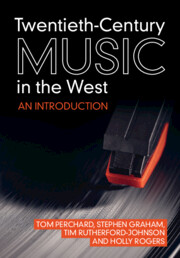Book contents
- Twentieth-Century Music in the West
- Twentieth-Century Music in the West
- Copyright page
- Contents
- Figures
- Tables
- Acknowledgements
- Introduction
- Part I Histories
- 1 Place and Space, Local and Global
- 2 Modernism
- 3 Postmodernism
- 4 Canons
- Part II Techniques and Technologies
- Part III Mediation
- Part IV Identities
- Bibliography
- Index
4 - Canons
from Part I - Histories
Published online by Cambridge University Press: 15 September 2022
- Twentieth-Century Music in the West
- Twentieth-Century Music in the West
- Copyright page
- Contents
- Figures
- Tables
- Acknowledgements
- Introduction
- Part I Histories
- 1 Place and Space, Local and Global
- 2 Modernism
- 3 Postmodernism
- 4 Canons
- Part II Techniques and Technologies
- Part III Mediation
- Part IV Identities
- Bibliography
- Index
Summary
As diverse as they may seem, the works of Schoenberg, Ella Fitzgerald, Ligeti, the Sex Pistols and Patti Smith all have something in common. From innovative, extended form to progressive and authentic performance style, the work of these diverse musicians has transcended changing tastes and styles to become firmly rooted in our musical culture. When the music of an artist continues to be played long after their death, or long after the music was released, and has exerted significant influence over subsequent musical practice, it can become part of a musical canon. A canon is a group of works considered by certain social and cultural groups to be the most significant and influential of a time period, style or genre. The consideration of a piece of music as an autonomous and bounded ‘work’ is a relatively new concept (➔Chapter 5, ‘Work and Notation’). In music, the Western art-music canon was the first to develop, but during the twentieth century, canons of punk, jazz, rock and pop formed as their commercial and critical apparatus developed.
- Type
- Chapter
- Information
- Twentieth-Century Music in the WestAn Introduction, pp. 104 - 128Publisher: Cambridge University PressPrint publication year: 2022



